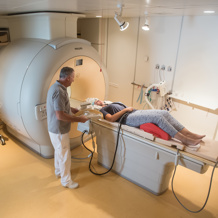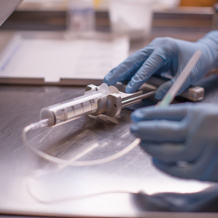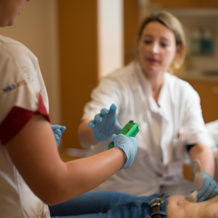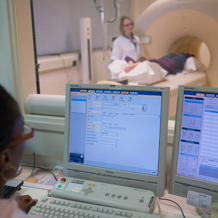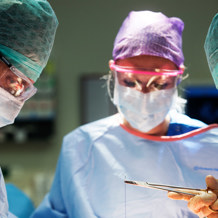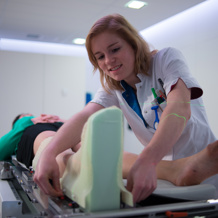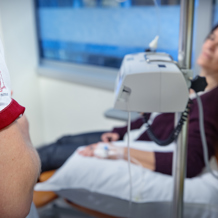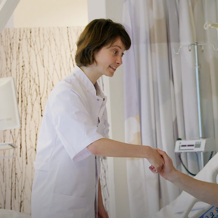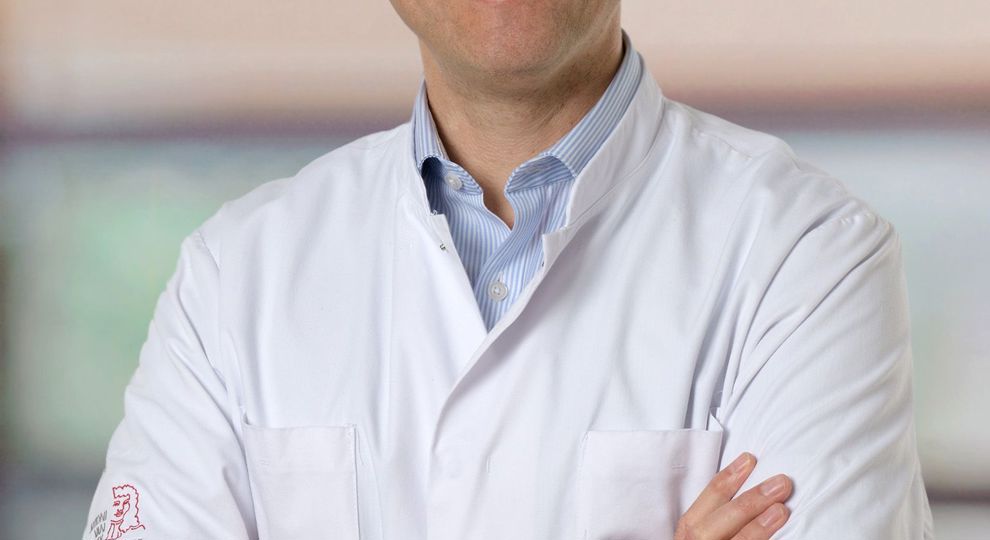Sarcoma
Sarcomas, also known as soft tissue tumors. Are malignant tumors that grow in the softer body parts. These tumors may develop in areas such as the muscles, nerves, fat, blood vessels, marrow, bone, or connective tissue between the organs. Some sarcoma types experience very slow growth, but others see rapid development. We treat all sarcoma types at the Netherlands Cancer Institute, with the exception of bone sarcoma.
Find out more about the causes and symptoms, and the most commonly used diagnostic tests and treatment types for sarcomas on this page.
Click here to read more about our NKI Sarcoma and GIST Center, our specialists, news, wait times, and the recent developments in sarcoma research.
Causes and symptoms
Sarcomas are rare and mainly develop in children and the elderly. It is currently unknown what causes sarcomas to develop. Some sarcomas have a hereditary factor. These cancer types usually do not cause any symptoms until they have developed into a later stage, when they start to press down on other organs, blood vessels, or nerves from their place in the connective tissue.
Sarcomas are most common in the legs (usually the upper legs), chest or abdominal wall, arms, or the head and neck area.
Sarcoma types
Sarcoma development
Sort tissue tumors may develop at various places in the body and are most common in:
- the legs; 40% (three quarters of which develop in the upper legs)
- the chest and abdomen; 30%
- the arms; 15%
- the head and neck area; 15%
Sarcoma in the abdomen
Retroperitoneal sarcoma
Retroperitoneal sarcomas are a special group of soft tissue tumors. Tumors that develop in the retroperitoneum are usually detected late by the patient because they do not develop inside of an organ but in the space in between organs. The tumors slowly start to push against the other organs in the abdomen once they have developed into a later stage. Retroperitoneal tumors are usually coincidentally discovered during imaging for different reasons.
Liposarcoma
Liposarcoma is the most common sarcoma type found in the abdomen (60-65%), a tumor consisting of fat cells. We differentiate between less aggressive types of liposarcoma (well-differentiated) and much more aggressive types of liposarcoma (poorly differentiated). Another type of liposarcoma is leiomyosarcoma (20-30%), a tumor type that appears in the abdomen and usually develops in the vascular wall. Other, less common types of abdominal sarcomas are the dedifferentiated pleomorphic sarcoma, malignant peripheral nerve sheath tumor, and the solitary fibrous tumor.
Gastrointestinal stromal tumors
Gastrointestinal stromal tumors are a more common type of tumor in the abdomen. These tumors develop in the intestinal wall. GISTs can develop throughout the entire digestive system but are most common in the stomach (60%). These tumor types may cause pain after eating, or even life-threatening bleeding, but are usually coincidentally detected without causing any symptoms. GISTs can behave in a wide variety of ways. Some are small abnormalities that remain stable for years, and others grow rapidly and spread throughout the body.
Borderline soft tissue tumor
Desmoid-type fibromatosis
Desmoid-type fibromatosis is a benign tumor that can be compared to restless tumor tissue. The cause of desmoid tumors is currently unknown. The tumor type is often found in surgical scar tissue or other trauma to the body. Hormones may affect its progression: the tumor is often detected during or after pregnancy in c-section scar tissue. Desmoid-type fibromatosis does not spread throughout the body, but its progression is often unpredictable. Patients can be divided into three groups: patients whose tumor initially grows and then shrinks, patients whose tumor remains stable for a long time, and patients with tumors that experience growth. When diagnosing the illness, we cannot determine which group the patient belongs in, so we usually start by carefully tracking the tumor through imaging techniques (ultrasound or MRI) before treating the tumor. If the tumor continues to grow and develop, or if it causes serious symptoms, we will opt for a treatment with prescription medicine or surgery.
Atypical lipomatous tumor
An atypical lipomatous tumor (ALT) or well-differentiated liposarcoma is a lipoma (tumor of the fat cells) that has the potential to grow. The tumor presents as an elastic swelling and is usually located underneath the skin or muscle. These fat cell tumors cannot spread through the body and are usually treated through surgery. Sometimes there are reasons to avoid surgical procedures, however. In elder patients with limited life expectancy, for example. Well-differentiated liposarcomas can also develop in the abdomen (in the retroperitoneum), where they have the potential to cause damage. These tumors are usually surgically removed.
Sarcomas occurring after prior radiation therapy
Approximately half of all oncology patients are treated with radiation therapy. Less than 1% of patients develops a sarcoma as a result of the treatment, anywhere between 2 or 20 years after the last dose pf radiation. 70% of these patients are women, and most of these women develop an radiation-induced angiosarcoma of the breast. Angiosarcomas are aggressive tumors that are generally treated with a combination of chemotherapy and surgery.
A second sarcoma type that is sometimes induced by radiation occurs in patients who have been treated for lymphoma. This group will get smaller with time, as we now treat most lymphoma patients with systemic therapies.
Dermatofibrosarcoma protuberans – soft tissue tumor of the skin
Dermatofibrosarcoma protuberans (DFSP) is a slow-growing tumor of the skin. It most commonly occurs in men and women between the ages of 20 and 40. DFSP can be locally aggressive and knows an infiltrative growth pattern, with a high recurrence rate. The suggested treatment is the surgical removal of the tumor and all surrounding tissue, after which the risk of recurrence will be much lower. DSFP is rarely metastatic – the only subgroup that spreads through the body is the ones that show the signs of malignant sarcoma when studied under a microscope. DFSP may respond to treatment with imatinib, which can be used to shrink the tumor prior to surgery.
rapid diagnostics
Every Tuesday we schedule a clinic for new patients coming in for rapid diagnostics or second opinions. The wait times will depend on the day of referral, but new patients can usually come to the clinic on the following Tuesday.
Frequently asked questions
Can a sarcoma/soft tissue tumor be benign as well as malignant?
Sarcomas / soft tissue tumors can be benign or malignant. The most common type of sarcoma is benign: the lipoma and fibroma. There is a subgroup of borderline tumors that can be locally aggressive without the risk of metastases: atypical lipomatous tumors (also known as dedifferentiated liposarcoma) and desmoid-type fibrosarcoma.
What do we know about the development of sarcoma/soft tissue tumors?
Very little is known about the development of soft tissue tumors. A very small group of tumors develops as a result of a hereditary disorder like neurofibromatosis type 1, Li-Fraumeni syndrome, or Gardner’s syndrome.
Long-term pesticide exposure, prior radiation treatment, or chronic lymphedema may play a part in the development of soft tissue tumors.
Why might it take longer before I will receive my biopsy results?
We used to classify soft tissue tumors by their microscopic qualities. Nowadays these classifications are more commonly made by their specific genetic (DNA) characteristics. This is the reason most biopsy results will take longer.
 nl
nl
 Nederlands
Nederlands

